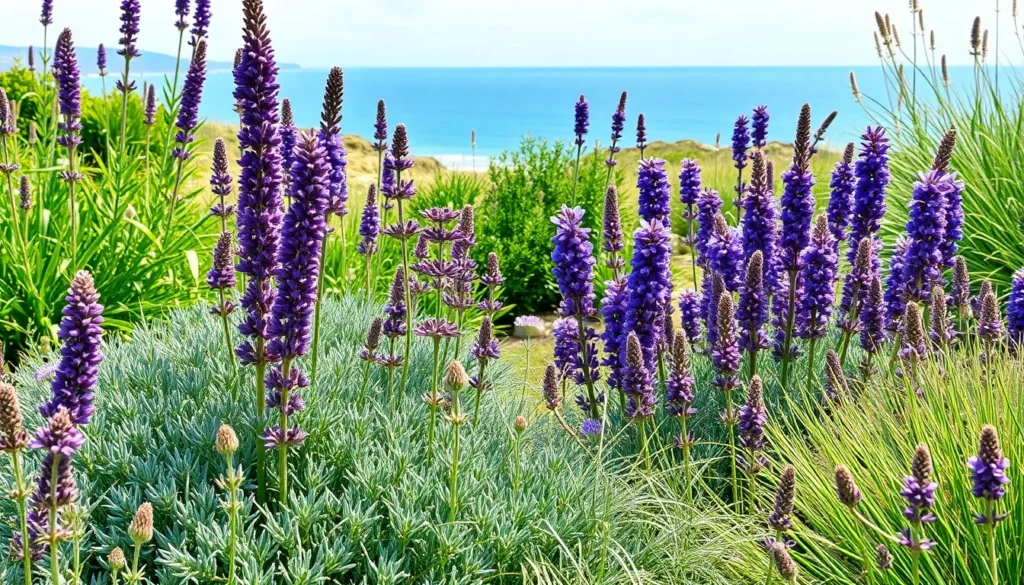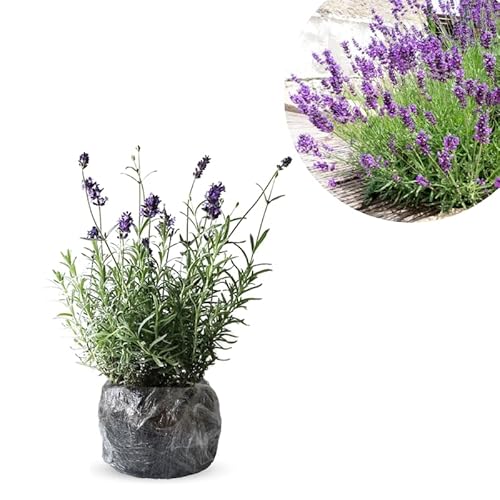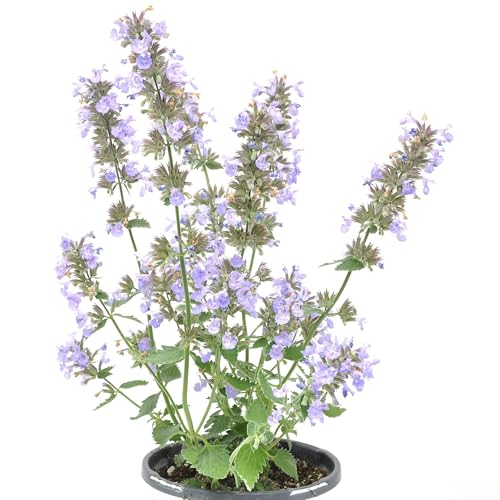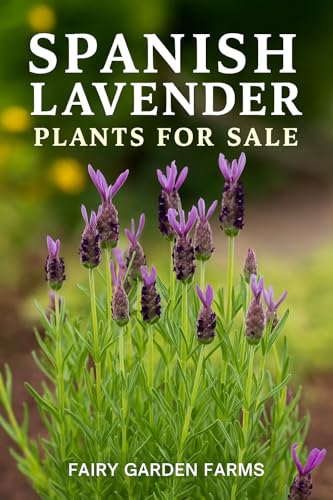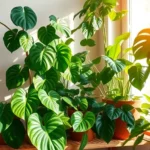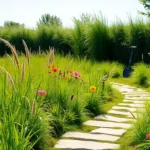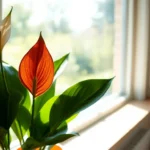We’ve all fallen in love with lavender’s distinctive purple spikes and soothing fragrance, but what happens when you want that same aesthetic appeal in different growing conditions? Whether you’re dealing with challenging climates, exact soil requirements, or simply want to expand your garden’s visual diversity, there’s a whole industry of plants that capture lavender’s enchanting beauty.
From drought-tolerant perennials to cold-hardy alternatives, these lavender look-alikes offer the same stunning purple blooms and silvery foliage we adore. Many even provide additional benefits like extended bloom times, different fragrance profiles, or better pest resistance.
We’re about to explore the most captivating plants that’ll give you that coveted lavender look without the fuss. These alternatives will transform your garden into a purple paradise while solving common growing challenges that traditional lavender might present in your exact location.
Russian Sage: The Silver-Leafed Lavender Lookalike
Russian sage stands out as one of the most convincing lavender alternatives for gardeners seeking that coveted purple and silver aesthetic. We’ve found this perennial to be particularly valuable in challenging growing conditions where traditional lavender struggles.
Distinctive Purple Flower Spikes
Russian sage produces stunning purple blue flower spikes that closely mimic lavender’s iconic appearance from mid summer through fall. These delicate tubular blooms arrange themselves in airy, branching clusters that create a soft, hazy effect in the garden industry. Unlike lavender’s compact flower heads, Russian sage displays a more open, architectural structure that adds textural interest to plantings.
The flowering period extends much longer than most lavender varieties, often continuing until the first hard frost. Each individual flower measures approximately 0.5 inches long and attracts beneficial pollinators including bees, butterflies, and hummingbirds throughout the extended bloom season. We particularly appreciate how the flowers maintain their color intensity even during hot summer months when other purple blooms tend to fade.
Aromatic Foliage and Growing Requirements
Russian sage foliage releases a distinctive sage like fragrance when brushed or crushed, though it differs from lavender’s sweet perfume. The silvery gray leaves create the same visual impact as lavender’s foliage, providing excellent contrast against darker plants in mixed borders. These narrow, deeply cut leaves measure 1 to 3 inches long and develop a whitish coating that helps the plant conserve moisture.
Growing Russian sage requires full sun exposure and well draining soil conditions similar to lavender’s preferences. This hardy perennial thrives in USDA zones 4 through 9, making it significantly more cold tolerant than most lavender species. We recommend spacing plants 3 to 4 feet apart since mature specimens can reach 3 to 5 feet in both height and width.
Drought tolerance makes Russian sage an excellent choice for xeriscaping and low maintenance gardens. Once established, plants require minimal watering and actually perform better in poor to average soils rather than rich, fertile conditions. Annual pruning in late winter helps maintain compact growth and promotes abundant flowering the following season.
Catmint: The Hardy Perennial Alternative
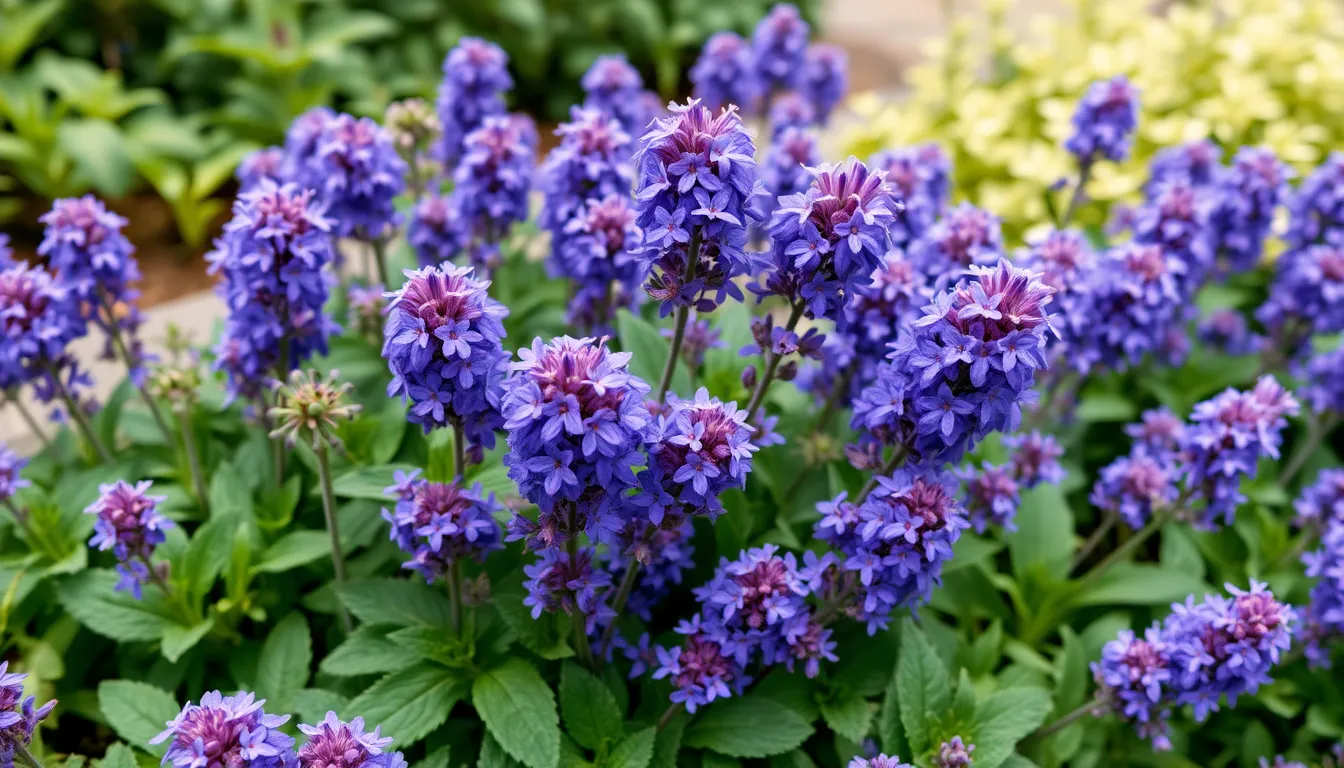
Catmint delivers an impressive combination of lavender-like aesthetics with superior durability that makes it a top choice for gardeners seeking reliable purple blooms.
Compact Growth Habit and Blue-Purple Blooms
Catmint’s low-growing nature creates dense mounds of blue-purple flowers that mirror lavender’s classic color palette while offering a more manageable size for smaller garden spaces. The plant produces abundant blooms throughout the growing season, creating continuous waves of color that rival traditional lavender displays.
Blue-purple flower spikes emerge from compact foliage, forming neat clusters that work perfectly as border plants or ground cover alternatives. We appreciate how catmint’s growth habit naturally stays contained without aggressive spreading, making it ideal for structured garden designs.
Dense flowering periods extend from late spring through early fall, providing months of vibrant purple color that attracts beneficial pollinators like bees and butterflies. The compact structure typically reaches 12-18 inches in height, creating perfect proportions for front-of-border plantings.
Low Maintenance Care Instructions
Easy growing requirements make catmint accessible to gardeners of all experience levels, requiring minimal intervention once established in the industry. We’ve found that this hardy perennial thrives in various soil conditions and tolerates both drought and moderate moisture levels.
Regular watering during establishment helps develop robust root systems, but mature plants handle dry periods better than most lavender varieties. The plant prefers well-draining soil but adapts to different soil types without special amendments.
Deadheading spent blooms encourages continuous flowering, though catmint will rebloom naturally without this maintenance step. We recommend cutting back the entire plant by one-third in mid-summer to promote fresh growth and extended blooming periods.
Winter hardiness surpasses many lavender species, making catmint suitable for colder climates where traditional lavender struggles to survive. The perennial returns reliably each spring, often expanding its coverage area naturally through self-seeding.
Rosemary: The Culinary Herb with Lavender Appeal
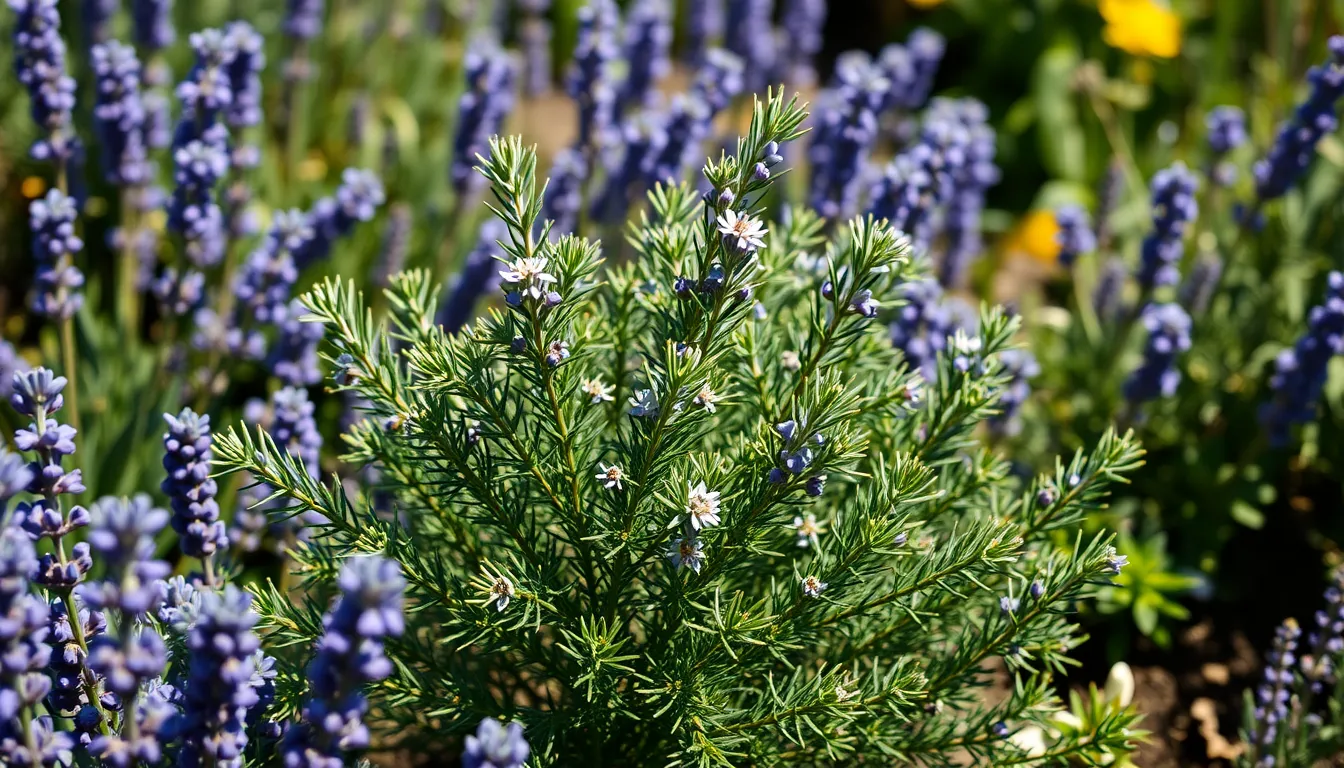
While rosemary doesn’t visually mimic lavender’s classic purple spikes and silvery foliage, this aromatic herb shares fascinating similarities that make it worth considering for gardeners seeking lavender alternatives.
Needle-Like Leaves and Fragrant Properties
Rosemary’s distinctive needle-like foliage creates a completely different visual texture compared to lavender’s soft, linear leaves. We find that these evergreen needles maintain their deep green color year-round, providing consistent structure in garden beds. The herb’s most compelling similarity to lavender lies in its powerful fragrance, which releases an intense pine-like aroma when brushed or crushed.
Essential oils concentrated within rosemary’s needle-shaped leaves produce this memorable scent, making it an excellent choice for sensory gardens. Gardeners often plant rosemary along pathways where foot traffic naturally releases its fragrance. The herb’s aromatic properties also serve practical purposes, naturally repelling certain garden pests like mosquitoes and cabbage moths.
Cooking Applications and Garden Uses
Rosemary excels as both a culinary staple and ornamental plant, offering dual functionality that many lavender lookalikes can’t match. We appreciate how this Mediterranean herb thrives in similar growing conditions to lavender, preferring full sun and well-draining soil. Fresh rosemary sprigs enhance roasted meats, potatoes, and bread recipes with their robust flavor profile.
Garden designers frequently incorporate rosemary into herb spirals, Mediterranean-themed landscapes, and drought-tolerant plantings. The herb’s woody stems develop into attractive, compact shrubs that can be pruned into formal hedges or topiary shapes. Mature rosemary plants produce small blue, white, or purple flowers that attract beneficial insects, adding unexpected color to their primarily green appearance.
Salvia: The Diverse Flowering Cousin
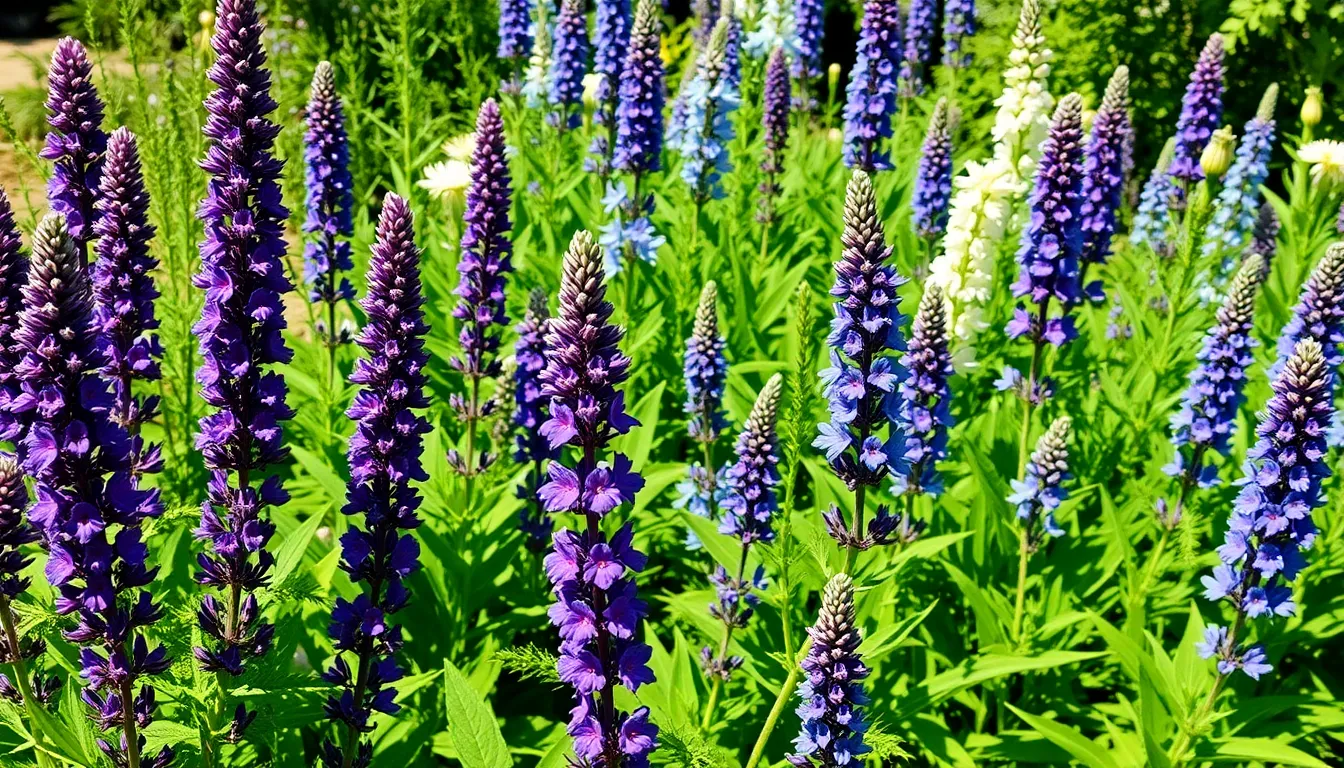
Salvia species offer some of the most convincing lavender alternatives we’ve discovered in our garden explorations. These versatile perennials deliver the purple flower power gardeners crave while bringing their own unique characteristics to industry designs.
Multiple Varieties That Mimic Lavender
Salvia nemorosa ‘Caradonna’ stands out as our top recommendation for achieving that coveted lavender aesthetic. This stunning cultivar produces deep violet purple flower spikes that closely resemble traditional lavender blooms while maintaining better cold hardiness in challenging climates.
Common characteristics we observe across salvia varieties:
| Salvia Type | Flower Color | Height Range | Bloom Period |
|---|---|---|---|
| Salvia nemorosa | Blue to purple | 12-24 inches | Late spring to fall |
| Salvia argentea | White with purple | 18-36 inches | Early to mid summer |
| Salvia pratensis | Blue, purple, pink | 12-30 inches | Late spring to summer |
Many salvia cultivars offer that signature blue purple flower combination gardeners associate with lavender fields. We’ve found varieties like ‘May Night’ and ‘East Friesland’ particularly effective at creating similar visual impact in garden borders and mass plantings.
Foliage texture varies significantly among salvia species compared to lavender’s consistent silvery appearance. Some varieties feature broader leaves with textured surfaces while others maintain more compact growth habits that complement lavender inspired garden designs.
Seasonal Blooming Patterns
Extended flowering periods make salvia varieties particularly attractive alternatives to traditional lavender plantings. Most salvia species begin blooming in late spring and continue producing fresh flower spikes through early fall with proper deadheading maintenance.
Peak blooming schedules we’ve documented:
- Early season: Flowers emerge in May and June
- Mid season: Continuous blooming through July and August
- Late season: Fresh blooms persist into September and October
Deadheading spent flowers encourages repeat blooming cycles throughout the growing season. We recommend cutting back flower stems to the first set of leaves after initial blooms fade to promote vigorous secondary flowering.
Temperature fluctuations affect blooming intensity across different salvia varieties. Cool weather tends to intensify flower colors while hot summer conditions may cause temporary flowering pauses until temperatures moderate in late summer.
Sea Lavender: The Coastal Garden Favorite
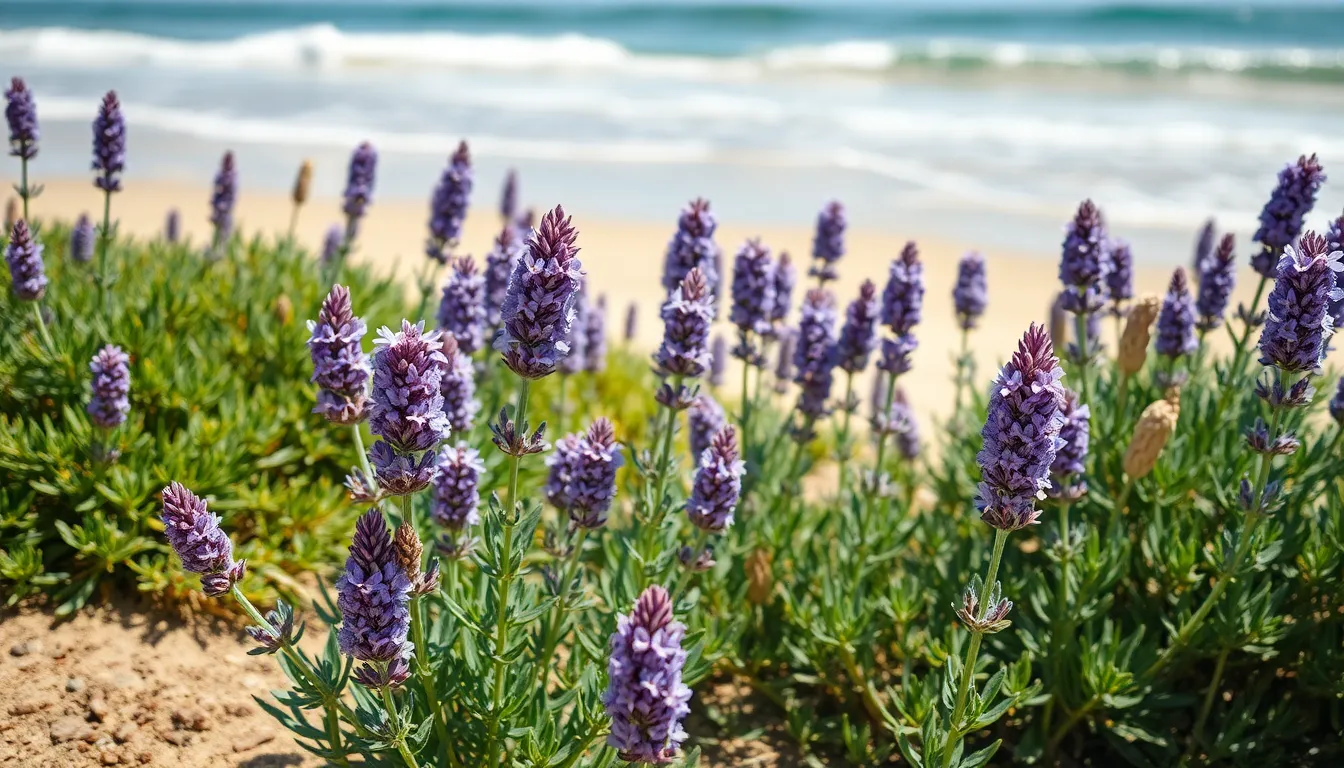
Sea lavender brings unique charm to gardens even though not being a true lavender species. We’ve discovered this coastal plant offers exceptional beauty for gardeners seeking lavender aesthetics in challenging growing conditions.
Papery Flower Clusters and Salt Tolerance
Papery flower clusters make sea lavender (Limonium carolinianum) instantly recognizable in coastal landscapes. We observe these delicate blooms creating stunning displays that persist throughout the growing season, maintaining their color and structure long after other flowers have faded. The flowers develop in dense, branching sprays that rise above the plant’s rosette of leaves.
Salt tolerance sets sea lavender apart from traditional lavender varieties and most garden plants. We’ve found this remarkable adaptation allows sea lavender to thrive in coastal conditions where salt spray would damage or kill other flowering plants. The plant’s natural habitat includes salt marshes and coastal areas, making it an excellent choice for seaside gardens.
Drought resistance complements sea lavender’s salt tolerance, creating a low maintenance plant perfect for challenging environments. We recommend this hardy perennial for gardeners dealing with poor soil conditions, coastal winds, and irregular watering schedules. The plant establishes deep root systems that help it survive extended dry periods.
Dried Flower Arrangements and Crafting
Dried flower arrangements benefit significantly from sea lavender’s natural preservation qualities. We’ve noticed the papery texture of sea lavender flowers makes them ideal for drying, maintaining their color and form for months or even years. Create enthusiasts particularly value this longevity when creating permanent floral displays.
Commercial florists frequently incorporate sea lavender into bouquets and arrangements because of its excellent drying characteristics. We observe that the flowers require minimal processing to achieve professional results, simply needing to be cut at the proper stage and hung to dry in a well ventilated area.
Color retention remains exceptional throughout the drying process, with sea lavender maintaining its soft purple hues long after harvest. We recommend harvesting the flowers when they’re fully open but before they begin to fade for optimal color preservation. The dried stems work beautifully in wreaths, potpourri, and other create projects where lasting color is essential.
Spanish Lavender: The True Lavender Relative
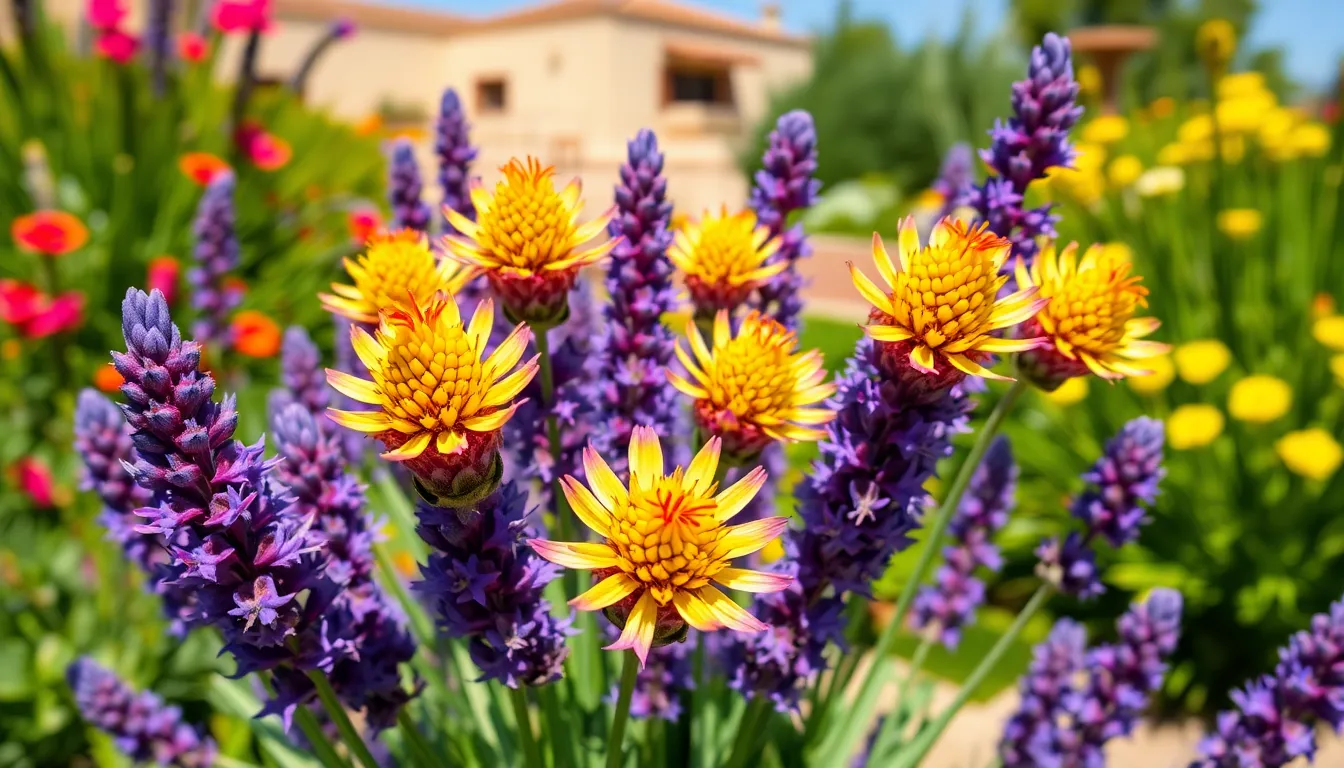
Spanish lavender offers gardeners an authentic lavender experience with unique visual characteristics that set it apart from common English varieties. This true lavender species provides Mediterranean garden appeal while delivering the classic lavender fragrance we love.
Distinctive Pineapple-Shaped Flower Heads
Spanish lavender’s most striking feature is its distinctive flower structure that resembles tiny pineapples topped with colorful bracts. These compact flower heads create dense, chunky spikes that differ dramatically from the slender, elongated flowers of English lavender varieties. Each flower head displays vibrant purple petals crowned with prominent papery bracts called “rabbit ears” that extend upward like delicate flags.
We appreciate how these unique flower formations provide extended visual interest throughout the blooming season. The bracts maintain their color and structure long after the actual flowers fade, creating a prolonged display that can last several weeks. Gardens benefit from this extended flowering period as Spanish lavender continues producing new flower heads from spring through fall in favorable conditions.
Pollinators find these distinctive flower shapes particularly attractive, with bees and butterflies frequently visiting the accessible nectar sources. The compact nature of each flower head concentrates the fragrance, making Spanish lavender an excellent choice for sensory gardens where visitors can easily enjoy the classic lavender scent.
Mediterranean Growing Conditions
Spanish lavender thrives in hot, dry conditions that mirror its native Mediterranean habitat. This variety tolerates intense summer heat better than most lavender species, making it ideal for gardens in warmer climates where English lavender might struggle. Full sun exposure throughout the day promotes the most vigorous growth and abundant flowering.
Well draining soil is essential for Spanish lavender success, as this plant cannot tolerate waterlogged conditions that lead to root rot. We recommend sandy or gravelly soil mixtures that allow excess moisture to drain quickly while still providing adequate nutrition. Soil pH should range between 6.5 and 7.5 for optimal growth, though Spanish lavender adapts to slightly more alkaline conditions than other lavender varieties.
Winter protection becomes necessary in zones colder than 8, as Spanish lavender shows less cold tolerance than its English counterparts. Container growing allows gardeners in northern climates to enjoy this variety by moving plants indoors during harsh winter months. The compact growth habit of most Spanish lavender cultivars makes container cultivation particularly successful.
Water requirements remain minimal once established, with deep but infrequent watering producing the best results. Overwatering dilutes the essential oils that create Spanish lavender’s intense fragrance, so we prefer allowing soil to dry between watering sessions.
Lamb’s Ear: The Soft-Textured Ground Cover
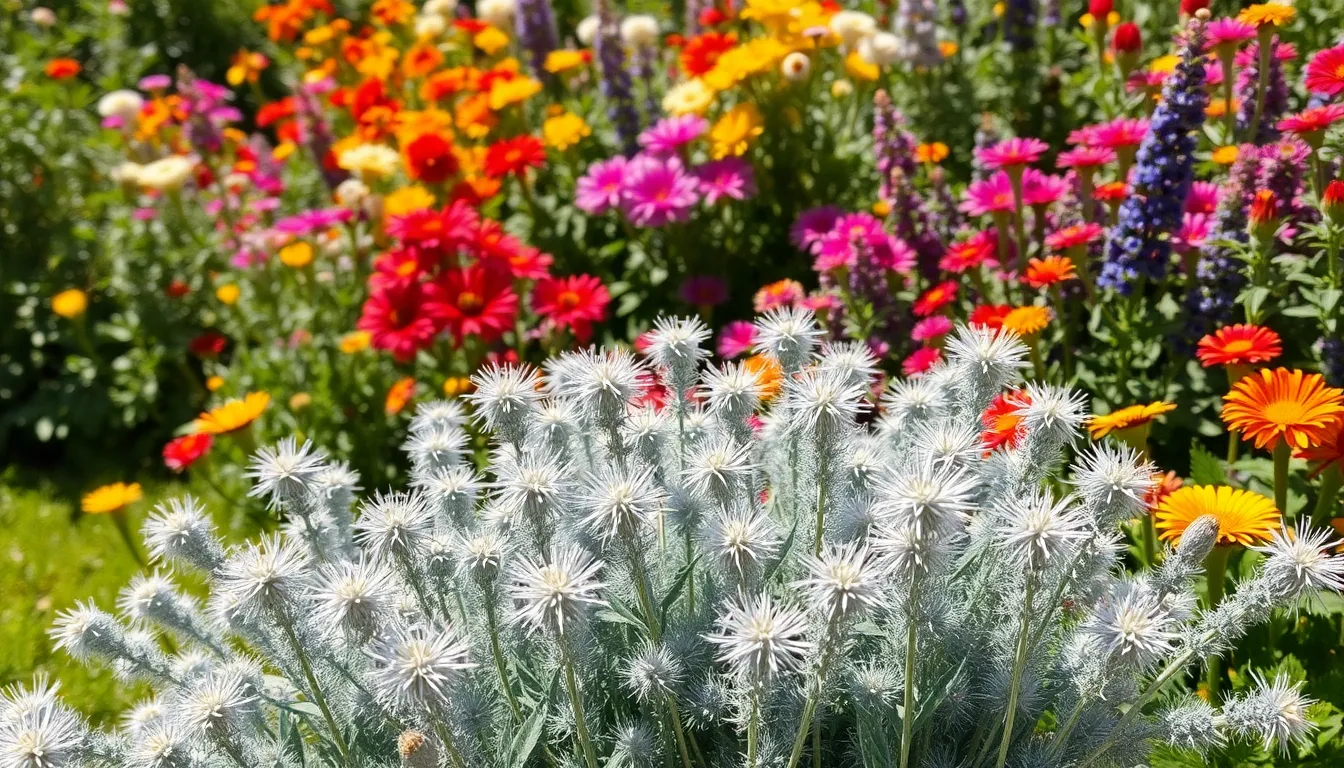
While Stachys byzantina doesn’t produce the classic purple flower spikes we associate with traditional lavender, its silvery gray foliage creates a similar aesthetic appeal in garden landscapes. We find this perennial particularly valuable for gardeners seeking lavender’s visual impact without requiring the same exact growing conditions.
Silvery Fuzzy Foliage Characteristics
Lamb’s Ear leaves display thick, oval or lance-shaped forms covered in dense silver-white hairs that create an unmistakably soft texture. Dense coverings of these fine hairs give each leaf a velvety quality that makes the plant popular in sensory gardens and decorative industry accents. Unlike lavender’s narrow, aromatic leaves, these broad foliage pieces provide a plush ground cover effect that contrasts beautifully with surrounding plants.
Tactile experiences define this plant’s primary appeal, as visitors often can’t resist touching the uniquely soft leaves. Silvery coloration helps reflect sunlight, contributing to the plant’s impressive heat tolerance in challenging growing conditions. We appreciate how this reflective quality maintains the foliage’s attractive appearance even during intense summer heat.
Drought Tolerance and Industry Uses
Established Lamb’s Ear demonstrates remarkable drought tolerance, making it an excellent choice for xeriscapes and low-water garden designs. Well-drained soil and full sun to partial shade conditions allow this hardy perennial to thrive with minimal irrigation requirements. Garden designers frequently incorporate it as border plantings, ground cover between stepping stones, or foliage accents in mixed perennial beds.
Spreading occurs naturally through self-seeding and stolons, though the plant remains manageable and non-invasive in most garden settings. We recommend it for gardeners seeking low-maintenance alternatives that provide visual interest without demanding constant attention. Its ability to establish quickly while remaining easy to control makes it particularly valuable for beginning gardeners or those with limited time for garden maintenance.
Lilyturf: The Grass-Like Lavender Substitute
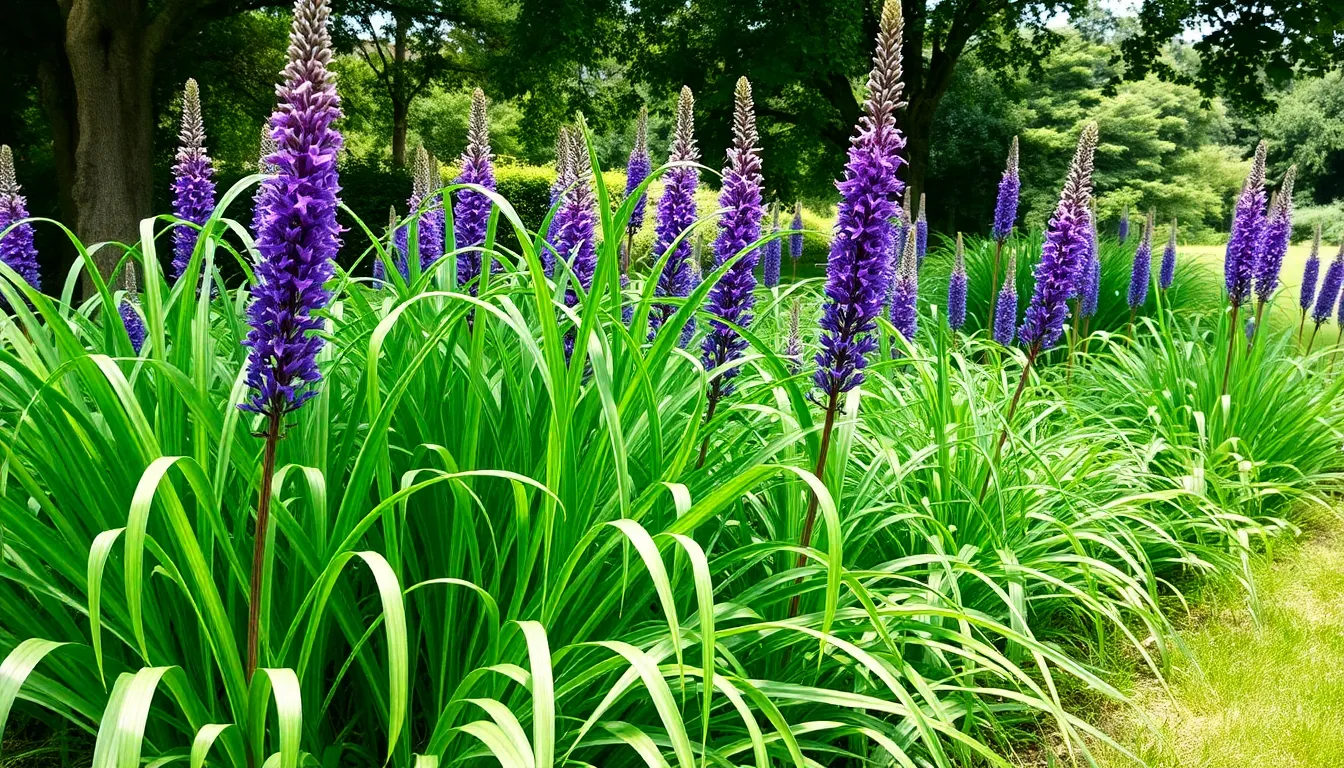
Lilyturf presents a unique alternative to traditional lavender by combining ornamental grass aesthetics with distinctive purple flower displays. This versatile plant offers gardeners an opportunity to achieve lavender-like visual impact in locations where conventional options might struggle.
Purple Flower Spikes on Ornamental Grass
Lilyturf produces distinctive purple flower spikes that emerge from grass-like foliage during late summer and early fall. These delicate blooms create vertical interest similar to lavender’s characteristic flower formation. The plant’s narrow, arching leaves form dense clumps that provide year-round structure in garden beds.
Flower spikes typically reach heights of 12 to 18 inches above the foliage base. Each spike contains many small purple flowers arranged in a dense, cylindrical pattern. The blooms attract pollinators while maintaining their visual appeal for several weeks during the flowering period.
Foliage color ranges from deep green to variegated patterns depending on the exact variety selected. Some cultivars feature cream or yellow striping along the leaf margins. The grass-like texture creates movement in the industry when touched by gentle breezes.
Shade Tolerance and Border Plantings
Lilyturf thrives in partial to full shade conditions where traditional lavender typically fails to perform. This shade tolerance makes it invaluable for woodland gardens and beneath tree canopies. The plant adapts well to filtered sunlight situations that would stress most lavender varieties.
Border plantings benefit from lilyturf’s neat growth habit and consistent appearance throughout growing seasons. Its clumping nature prevents aggressive spreading while filling designated spaces effectively. Garden designers frequently incorporate lilyturf along walkways and property edges for defined boundaries.
Maintenance requirements remain minimal once plants become established in their growing locations. Lilyturf tolerates various soil types and moisture levels better than most lavender alternatives. Its evergreen nature provides continuous visual interest even during dormant winter months in milder climates.
Speedwell: The Compact Flowering Option
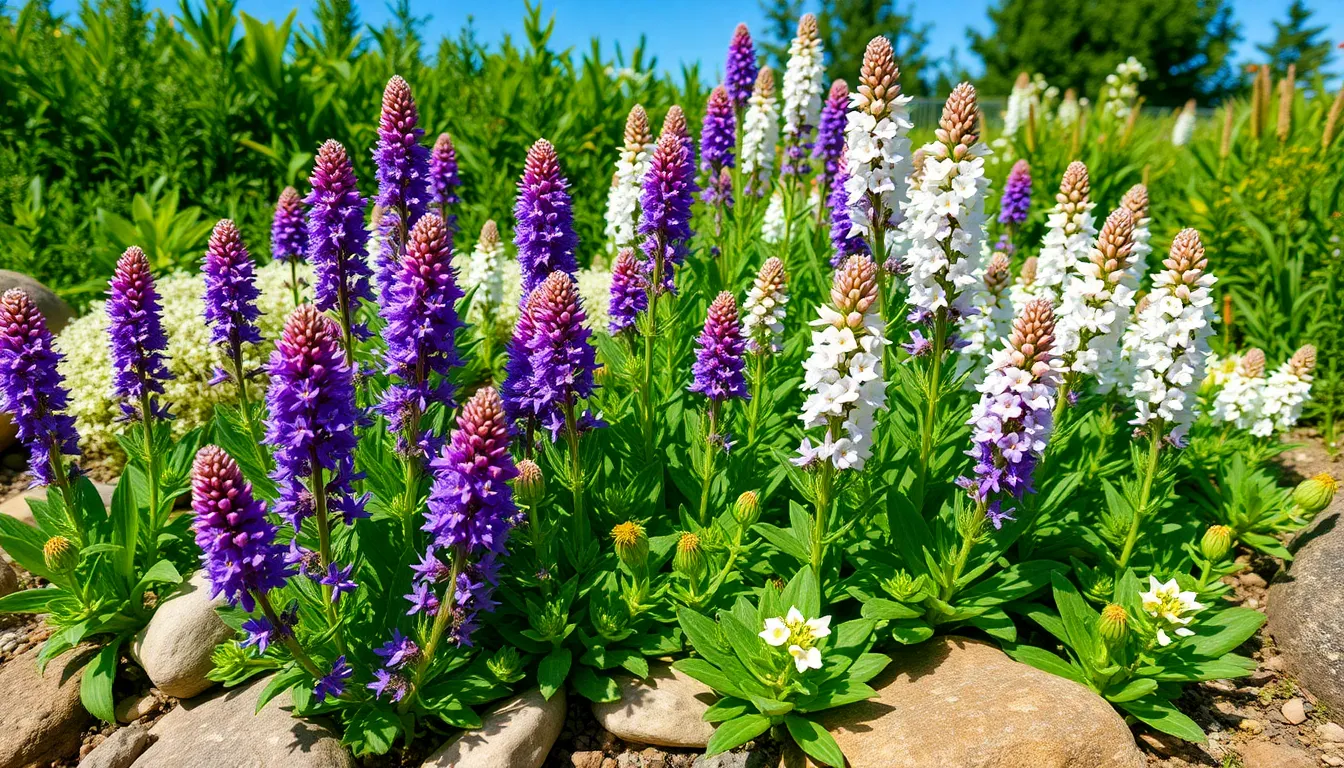
Speedwell plants deliver impressive flowering displays in remarkably small packages, making them perfect alternatives to lavender for gardeners working with limited space. We’ve found these versatile perennials offer the same upright flower spikes and extended blooming periods that make lavender so desirable.
Dense Flower Spikes in Various Colors
Speedwell produces compact flower spikes that rival lavender’s classic appearance while offering an expanded color palette beyond traditional purple. The dense flower clusters create striking vertical elements in garden designs, with blooms typically reaching 6 to 12 inches in height. Popular varieties include Veronica spicata ‘Royal Candles’ with deep purple spikes, ‘Red Fox’ featuring rose-pink blooms, and ‘Alba’ offering pure white flowers.
These flowering spikes emerge from late spring through early fall, providing continuous color throughout the growing season. Each individual flower measures only a few millimeters across, but they’re packed tightly together to form substantial displays. The blooming period extends for 8 to 12 weeks when properly maintained, with deadheading encouraging additional flower production.
Speedwell’s flower spikes attract beneficial pollinators including bees, butterflies, and hummingbirds throughout their extended blooming cycle. The nectar-rich blooms serve as important food sources during peak summer months when other flowers may be scarce. We’ve observed that speedwell’s compact growth habit makes it easier to incorporate into pollinator gardens without overwhelming smaller companion plants.
Rock Garden and Container Applications
Speedwell excels in rock gardens where its compact size and drought tolerance make it an ideal choice for filling gaps between stones and creating colorful accents. The plant’s maximum height of 12 to 18 inches fits perfectly within rock garden proportions, while its spreading habit helps soften hard edges and transitions. Most speedwell varieties thrive in well-draining soil conditions that naturally occur in rock garden settings.
Container gardening benefits significantly from speedwell’s manageable size and long flowering period, making it perfect for patios, balconies, and small outdoor spaces. We recommend using pots at least 8 inches deep to accommodate the plant’s root system, with drainage holes essential for preventing waterlogged conditions. Speedwell performs exceptionally well in mixed container plantings, serving as a reliable backdrop for seasonal annuals.
The plant’s cold hardiness extends to USDA zones 3 through 8, allowing container grown speedwell to overwinter outdoors in most temperate climates. Root protection becomes important in the coldest zones, where moving containers to sheltered locations or wrapping them with insulating materials helps ensure survival. Speedwell’s low water requirements make it suitable for container gardens with infrequent watering schedules, particularly valuable during hot summer months.
Perovskia: The Architectural Garden Statement
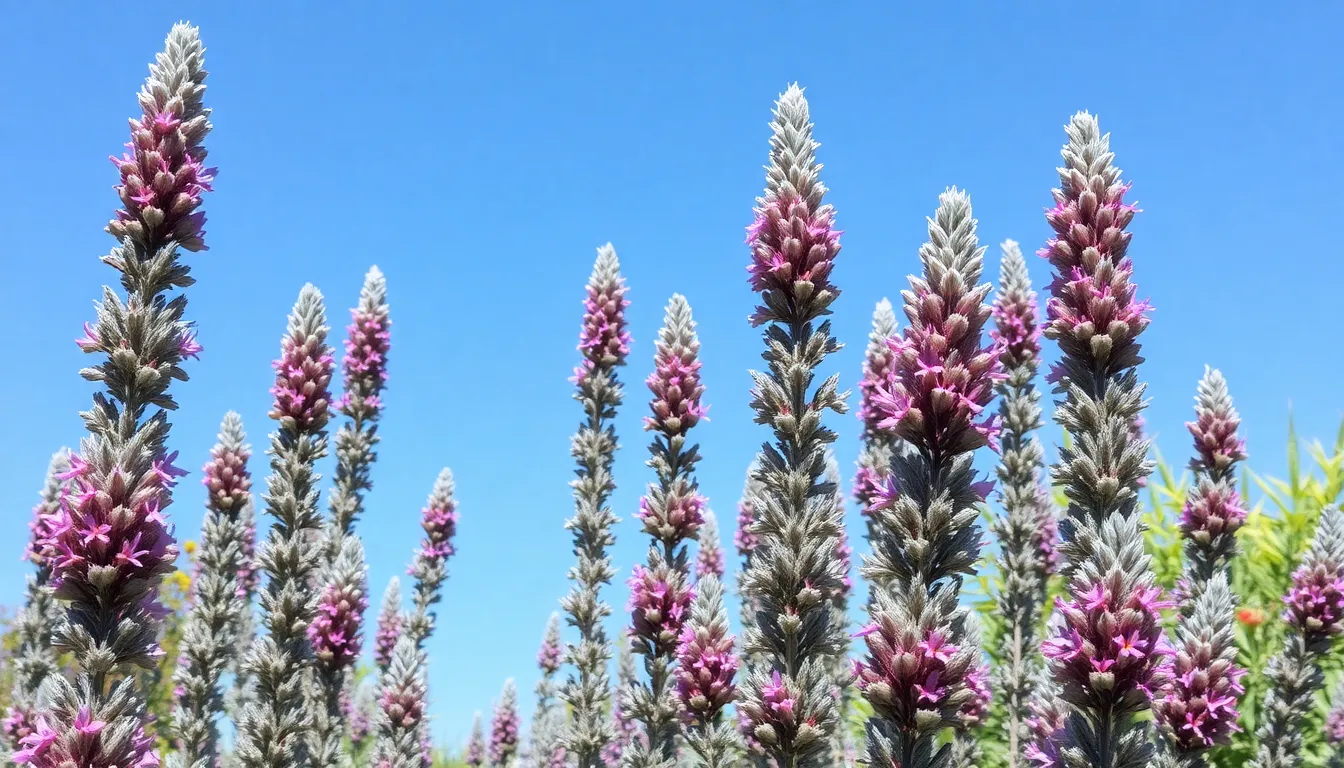
Russian sage stands out as the most architecturally striking lavender alternative we’ve encountered in garden design. This perennial creates dramatic vertical elements that rival any ornamental grass while delivering the purple flower power gardeners crave.
Tall Spiky Growth and Late Summer Blooms
Towering specimens of Russian sage reach impressive heights of 3 to 5 feet, creating commanding focal points in garden borders and industry designs. The plant’s airy spikes of small mauve flowers emerge in mid-summer and continue their spectacular display well into fall, extending the blooming season far beyond traditional lavender varieties.
Silvery gray foliage provides stunning contrast against the purple flower clusters, creating visual depth that enhances any garden composition. We’ve observed how the plant’s open, branching structure allows light to filter through its stems, preventing the heavy appearance that some tall perennials can create in smaller spaces.
Late season bloomers like Russian sage fill the crucial gap when many summer flowers begin to fade, ensuring continuous color throughout the growing season. The flowers develop their most intense coloration during cooler autumn temperatures, often becoming more vibrant as the season progresses.
Xeriscaping and Water-Wise Gardening
Drought tolerance makes Russian sage an exceptional choice for water-conscious gardeners seeking low-maintenance alternatives to traditional lavender plantings. Once established, this resilient perennial thrives with minimal supplemental watering, making it perfect for xeriscaping projects and areas with water restrictions.
Well-draining soil conditions suit Russian sage perfectly, as the plant actually performs better in poor to average soils than in rich, moisture-retentive garden beds. We recommend avoiding heavy clay soils or areas with poor drainage, as excess moisture can lead to reduced flowering and potential root problems.
Full sun exposure brings out the best qualities in Russian sage, intensifying both flower color and foliage contrast while promoting the sturdy growth habit that makes this plant so architecturally valuable. The plant’s natural resistance to deer and rabbits adds another layer of practical benefit for gardeners dealing with wildlife pressure.
Water-wise garden designs benefit tremendously from Russian sage’s ability to maintain its attractive appearance during extended dry periods, requiring irrigation only during establishment or severe drought conditions.
Conclusion
These lavender alternatives open up exciting possibilities for gardeners who’ve struggled with traditional lavender cultivation. Whether you’re dealing with harsh winters challenging soil conditions or simply want to expand your garden’s visual appeal each of these plants offers unique advantages while maintaining that coveted purple-and-silver aesthetic.
From Russian sage’s architectural drama to catmint’s reliable blooms these alternatives often outperform traditional lavender in durability and flowering periods. They’ve proven themselves in diverse growing conditions making beautiful gardens accessible to more gardeners regardless of climate or experience level.
We encourage you to experiment with these options and discover which ones work best in your exact growing conditions. Your garden will benefit from the extended bloom times improved cold tolerance and unique characteristics these remarkable plants bring to any industry design.
Frequently Asked Questions
What is the best lavender alternative for cold climates?
Russian sage is the top choice for cold climates. It closely mimics lavender’s purple and silver aesthetic while being more cold-tolerant than most lavender species. This hardy perennial produces purple-blue flower spikes from mid-summer through fall and thrives in full sun with well-draining soil.
Which lavender substitute blooms the longest?
Catmint offers one of the longest blooming periods among lavender alternatives. It produces continuous waves of blue-purple flowers from late spring through early fall, extending far beyond most traditional lavender varieties while requiring minimal maintenance.
Can I use rosemary as a lavender replacement in cooking gardens?
Yes, rosemary serves as an excellent dual-purpose alternative to lavender. While it doesn’t have purple flowers, it shares similar growing conditions (full sun, well-draining soil) and provides powerful fragrance plus culinary value. Its needle-like evergreen foliage offers year-round structure.
What lavender alternative works best in coastal areas?
Sea lavender is ideal for coastal environments due to its exceptional salt tolerance. It produces distinctive papery flower clusters that persist throughout the growing season and thrives in challenging coastal conditions where other plants may struggle.
Which plant looks most like traditional lavender?
Salvia nemorosa ‘Caradonna’ most closely resembles traditional lavender with its deep violet flower spikes. This hardy perennial offers superior cold tolerance and blooms from late spring through early fall with proper deadheading.
What lavender substitute is best for shade gardens?
Lilyturf is perfect for shaded areas where traditional lavender cannot grow. It produces purple flower spikes from grass-like foliage during late summer and fall, thriving in partial to full shade with minimal maintenance requirements.
Is Spanish lavender a good alternative to English lavender?
Spanish lavender is actually a true lavender species with unique pineapple-shaped flower heads and colorful bracts. It’s ideal for hot, dry climates but less cold-tolerant than English lavender. Container growing allows northern gardeners to enjoy it.
What’s the best low-maintenance lavender alternative?
Lamb’s Ear requires minimal care while providing silvery-gray foliage similar to lavender. Though it lacks purple flowers, its drought tolerance, self-seeding ability, and soft texture make it perfect for low-maintenance gardens and sensory landscapes.
Which lavender substitute is best for small spaces?
Speedwell is ideal for compact areas and container gardens. This drought-tolerant plant produces upright purple flower spikes, attracts pollinators, and maintains a small footprint while delivering impressive displays in limited space.
What lavender alternative creates the most dramatic garden impact?
Russian sage creates the most architectural drama, reaching 3-5 feet tall with airy mauve flower spikes. Its impressive height and drought tolerance make it perfect for creating vertical elements and filling gaps in late-summer garden displays.

